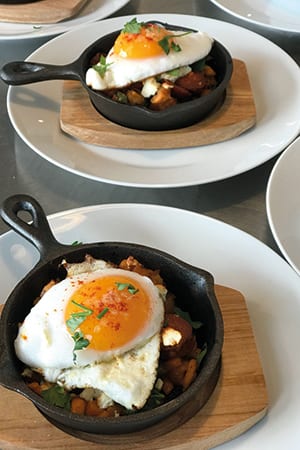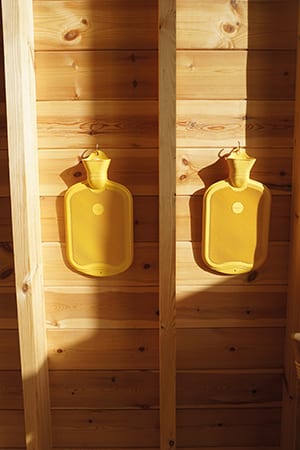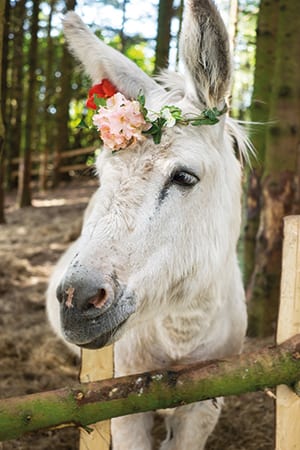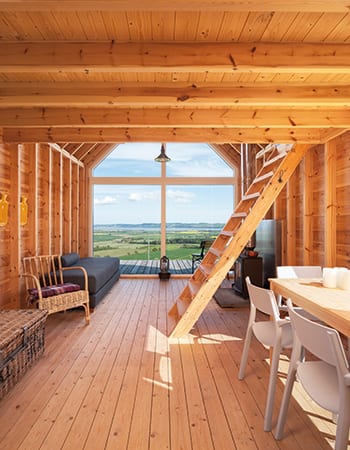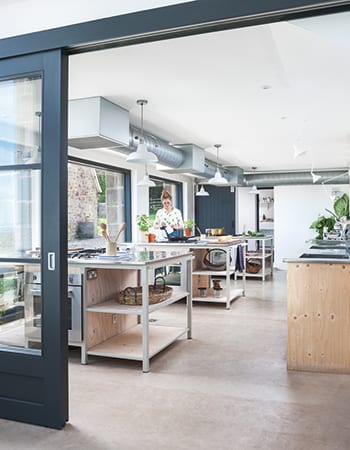Her family farm in Perthshire hosts laid-back weddings and craft workshops, produces delicious home-cooked food, and rents out gorgeous get-away-from-it-all boltholes – proof there’s a better way to live off the land
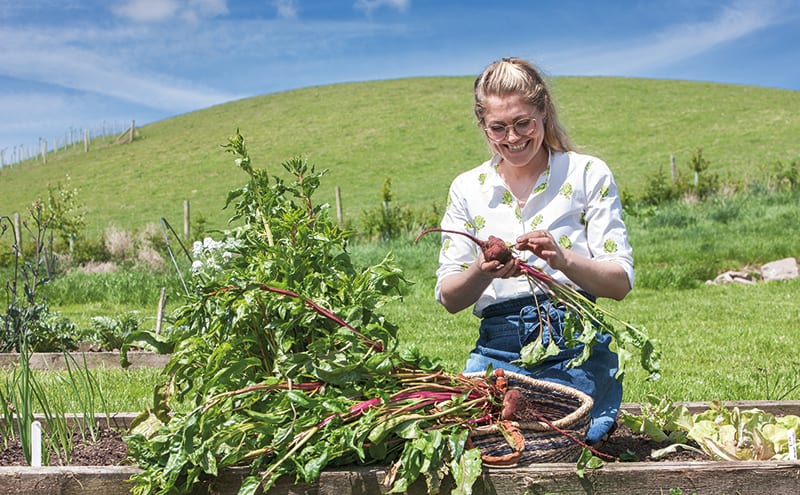
DETAILS
Photography Neale Smith
Art direction Gillian Welsh
Words Catherine Coyle
Growing up in the Perthshire countryside in the 1960s, Fiona Lamotte dreamed of one day moving to the top of the hill at Inchture and living on a farm that looked out over the braes of the Carse of Gowrie, the 20-mile stretch of rich farmland near the Firth of Tay. These were the fields, the grasslands, the landscapes that were the backdrop to her childhood, and the idea of being able to take up residence in her favourite spot up the hill and inhale those views every morning became a lifelong ambition.
Well, she managed it. And what has made it even more rewarding is that she gets to experience it in the company of her entire family. It’s here, at Guardswell Farm at Kinnaird, with her husband Richard, daughter Anna and sisters Susan and Gillian, that the Lamottes live out their dream. It’s the epitome of a family affair.

The family are well and truly from farming stock, but their new venture at Guardswell Farm does things a little differently, seeking to adopt a far more inclusive approach than a traditional farmer might take. In fact, involving the community and inviting guests from all over Scotland (and further afield) to enjoy the farm is at the very heart of what they do.
“My grandfather Robert – Fiona’s dad – was a dairy farmer and they had a farm in the Carse of Gowrie,” explains 27-year-old Anna Lamotte, the general manager, “but when the quota system was enforced in the 1980s, he decided to go in a new direction, diversifying into herbs.” The idea had come from Anna’s gran, who loved cooking with herbs; when she couldn’t find any to buy, she decided to grow her own.

This soon developed into a substantial herb nursery in a Victorian greenhouse and parterre that Anna remembers fondly from her childhood. “My papa started to sell freshly cut herbs and was the first to stock all the big supermarkets and restaurants with them. I remember spending lots of time in the herb van, driving around doing deliveries with him,” she smiles.
As Scotherbs grew to meet demand, Anna’s mum Fiona and aunts Gillian and Susan were busy running the Buttery, a seasonal café and cook school in the nearby town of Errol, using the best local produce and lots of herbs in their menus.
Anna and her younger sister Kirsten (who is now in Canada, working on an organic farm in British Columbia) grew up in this environment, immersed in the countryside, helping out with the family businesses and aware of the importance of investing in the land that provides so much. “When Guardswell Farm came up for sale, my mum knew she wanted to look after it,” recalls Anna, “but we didn’t do anything with it straight away.”
The farm’s buildings were falling down and the family had to decide whether to demolish it all and start again, or try to turn what they had into something special. Before that happened, events took over; Anna had just completed a three-month cookery course at the prestigious Ballymaloe Food School in Ireland when her father suffered a stroke; it changed what he was able to do, and the Scotherbs business was sold.
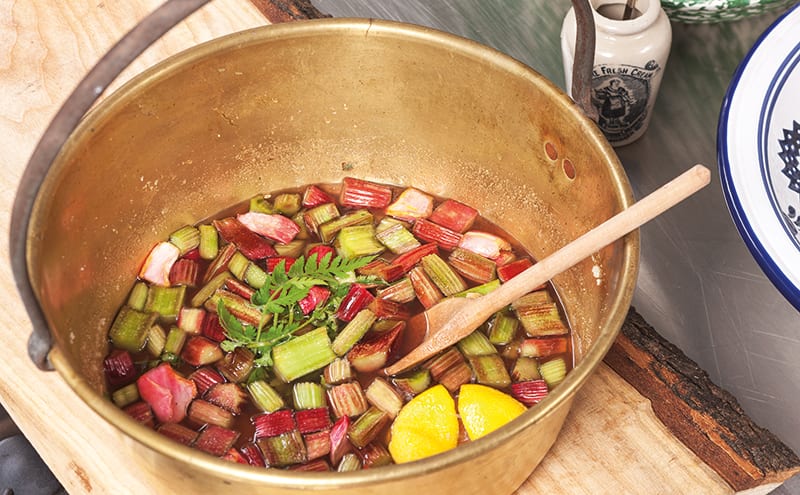
“Guardswell felt like a wonderful opportunity to do something along the lines of food, education, rural skills, allowing people to really step back from their busy lives,” she explains.
The renovation got underway and before long the plans had expanded quite dramatically. “It really did grow arms and legs; it was meant to be a few huts, a shower room and sitting-room space – and then it turned into an entire steading conversion that can host up to 200 people for an event, such as a wedding, with space for 30 to stay on site.”
The Lamottes knew that they didn’t want to change everything about the farm, preferring to find ways to preserve and modernise whatever could be saved. Architects Ben and Rosemary Scrimgeour came on board, eager to recycle what they could and rehabilitate the more dilapidated farm buildings. The project has been shortlisted in this year’s RIAS/RIBA awards, one of two the husband-and-wife team have in the running for the prestigious prize.
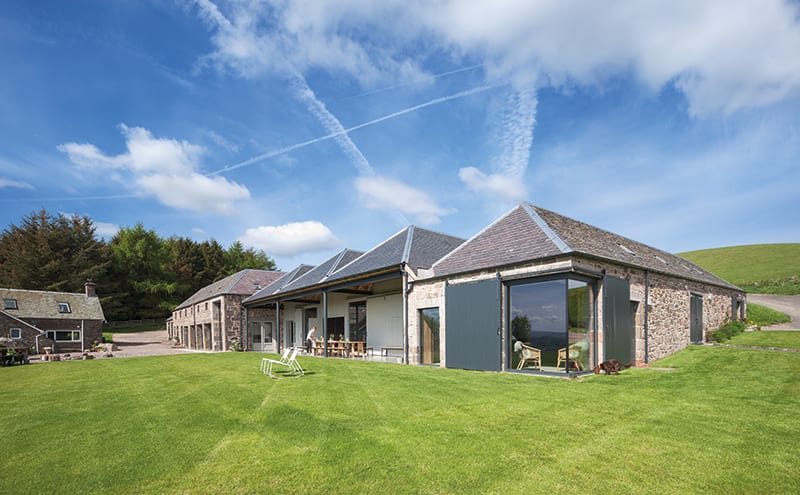
The steading has been converted and now forms the main events area, with timber that was salvaged from the original roof used to clad the walls. What was the bull pen now forms a neat snug with a glazed corner where, Anna says, the grannies and aunties converge at weddings. The family and the architects felt it was crucial to keep the building looking authentically agricultural, so they opted not to change the structure.
The old cattle court and feed passage leads through to a more formal space that was once the granary. This has the atmosphere of a simple art gallery, and its cool calmness lends itself well to wedding ceremonies and yoga retreats. “It was important for us to bring in lots of light, so we put in windows everywhere for the views,” says Anna, gesturing out towards the impressive panorama.
The outside was, arguably, more important than the interiors to the Lamottes, so in addition to the accommodation (two cottages, a farmhouse and three huts), they look after 150 acres of land, where a committed programme of biodiversity has been started. With Scotia Seeds, native wildflowers have been planted in the rich grasslands to give wildlife the chance to thrive, while some 10,000 trees have been planted with the help of the Woodland Trust in an attempt to help the farmland evolve.
Two donkeys and 25 Hebridean sheep manage the meadows, and there’s a vegetable garden that was planted by Anna’s grandfather Robert, who died in January this year.
Anna does all the cooking and runs the events at Guardswell. Her mum, Fiona, meanwhile, refers to herself as the ‘donkey manager’. Gillian and Susan are in charge of housekeeping and gardening, respectively, with Anna’s dad and the only non-family member Jamie taking on all of the outside tasks – everything from mowing the lawns to repairing the guttering and mending the fences.
Weddings were Guardswell’s bread and butter in its first year (it only opened in June 2017), with the trend for rustic, countryside celebrations making it an incredibly popular venue, but the idea is to scale the weddings back to just one every fortnight in the future (the venue is fully booked for the next 18 months with a hefty waiting list for 2020), to allow more time and space for the other events that take place here.

There are cookery classes, both for adults and children (as well as for local schools), and craft-making, such as leather workshops led by Jude Gove and spoon carving by Louise Forbes. There are also farm brunches – with these, you are invited to spend a day at the farm, first in the Cart Shed kitchen eating home-grown, seasonal food, drinking good coffee and reading the Sunday papers in peace, without anyone eyeing your table, then taking a walk around the wild meadow lands or simply sitting and enjoying a few hours of wi-fi-free life.
Anna manages the accommodation – the farmhouse, two cottages and three huts – all of which have the same simple, pared-back aesthetic that she favours. The huts, named Pendicle, Infield and Kailyard, were constructed by local joiner Craig Anderson to the family’s specification, and are used as self-catering boltholes where guests can completely switch off.
Their timbers will weather and blend into the landscape; inside, natural sheepskins and unfussy enamelware make it clear that a stay at Guardswell Farm is designed to bring you closer to nature. “I’m a bit of an interiors junkie – I’m the one who likes to make things look pretty,” says Anna, who admits to being a big fan of Heal’s.
Her relaxed attitude extends to her decorating style. She has a strong eye for finding the right balance between maximising the rustic elements of the properties here, while tempering them with Scandinavian-inspired accessories. She found a lot of the furnishings at the Scottish Antique and Arts Centre at nearby Abernyte, with prints and textiles from her travels thrown in alongside freshly cut flowers and home-grown produce.
“I would probably say I like anything a little bit Scandi – although I think Scottish is the new Scandi – and I like using natural materials, really clean and fresh… Just keep the tartan-covered, antler-clad interiors away from me! I think we have something, in an interiors sense, way more impressive and contemporary to give as a country – drawing on our landscape and materials at hand as inspiration.”
The family business now has strong foundations, and the future looks bright. “We’re still in our infancy,” smiles Anna, “and we’re always thinking about how we can run the farm in the most sustainable way.” Taking off over the Christmas and New Year shutdown, she is planning an adventure-packed trip overseas. Travel, though, won’t just be a chance to unwind; she’ll be seeking new sources of inspiration to bring home to Guardswell Farm.


